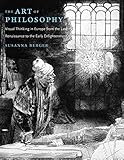The Art of Philosophy : Visual Thinking in Europe from the Late Renaissance to the Early Enlightenment / Susanna Berger.
Material type: TextPublisher: Princeton, NJ : Princeton University Press, [2017]Copyright date: ©2017Description: 1 online resource (352 p.) : 30 color illus. 169 halftonesContent type:
TextPublisher: Princeton, NJ : Princeton University Press, [2017]Copyright date: ©2017Description: 1 online resource (352 p.) : 30 color illus. 169 halftonesContent type: - 9780691172279
- 9781400885121
- Aesthetics, Modern -- 17th century
- Aesthetics, Modern -- 18th century
- Art and philosophy -- Europe
- Art, Modern -- 18th century
- Art, Renaissance
- Visual communication in art -- Europe -- History
- ART / History / Renaissance
- Aristotle
- Bosse
- Drer
- Girard Desargues
- Justus Winkelmann
- Leviathan
- Logicae universae typus
- Paris philosophy notebooks
- Siegmund Jacob Apin
- Typus
- Willibald Pirckheimer
- alba amicorum
- art
- dissertation
- drawing
- early modern period
- engravings
- escriptio
- friendship albums
- frontispiece
- lecture notebooks
- logic
- manuscript
- manuscripts
- mental representation
- metaphysics
- mnemonic printed images
- moral philosophy
- natural philosophy
- philosophical images
- philosophical knowledge
- philosophical thought
- philosophical understanding
- plural images
- visual art
- visual commentary
- visual images
- visual representation
- visualization
- 190 23
- BH39 .B47 2018
- online - DeGruyter
- Issued also in print.
| Item type | Current library | Call number | URL | Status | Notes | Barcode | |
|---|---|---|---|---|---|---|---|
 eBook
eBook
|
Biblioteca "Angelicum" Pont. Univ. S.Tommaso d'Aquino Nuvola online | online - DeGruyter (Browse shelf(Opens below)) | Online access | Not for loan (Accesso limitato) | Accesso per gli utenti autorizzati / Access for authorized users | (dgr)9781400885121 |
Frontmatter -- Contents -- Acknowledgments -- Abbreviations -- Introduction -- 1. Apin's Cabinet of Printed Curiosities -- 2. Thinking through Plural Images of Logic -- 3. The Visible Order of Student Lecture Notebooks -- 4. Visual Thinking in Logic Notebooks and Alba amicorum -- 5. The Generation of Art as the Generation of Philosophy -- Appendix 1. Catalogue of Surviving Impressions of Philosophical Plural Images -- Appendix 2. Transcriptions of the Texts Inscribed onto Philosophical Plural Images -- Notes -- Bibliography -- Index -- Illustration Credits
restricted access online access with authorization star
http://purl.org/coar/access_right/c_16ec
The first book to explore the role of images in philosophical thought and teaching in the early modern periodDelving into the intersections between artistic images and philosophical knowledge in Europe from the late sixteenth to the early eighteenth centuries, The Art of Philosophy shows that the making and study of visual art functioned as important methods of philosophical thinking and instruction. From frontispieces of books to monumental prints created by philosophers in collaboration with renowned artists, Susanna Berger examines visual representations of philosophy and overturns prevailing assumptions about the limited function of the visual in European intellectual history.Rather than merely illustrating already existing philosophical concepts, visual images generated new knowledge for both Aristotelian thinkers and anti-Aristotelians, such as Descartes and Hobbes. Printmaking and drawing played a decisive role in discoveries that led to a move away from the authority of Aristotle in the seventeenth century. Berger interprets visual art from printed books, student lecture notebooks, alba amicorum (friendship albums), broadsides, and paintings, and examines the work of such artists as Pietro Testa, Léonard Gaultier, Abraham Bosse, Dürer, and Rembrandt. In particular, she focuses on the rise and decline of the "plural image," a genre that was popular among early modern philosophers. Plural images brought multiple images together on the same page, often in order to visualize systems of logic, metaphysics, natural philosophy, or moral philosophy.Featuring previously unpublished prints and drawings from the early modern period and lavish gatefolds, The Art of Philosophy reveals the essential connections between visual commentary and philosophical thought.
Issued also in print.
Mode of access: Internet via World Wide Web.
In English.
Description based on online resource; title from PDF title page (publisher's Web site, viewed 30. Aug 2021)


